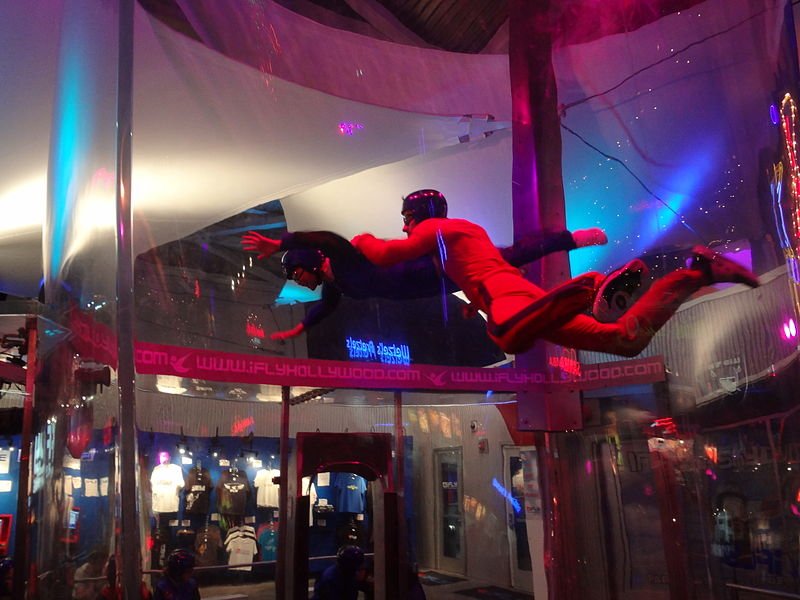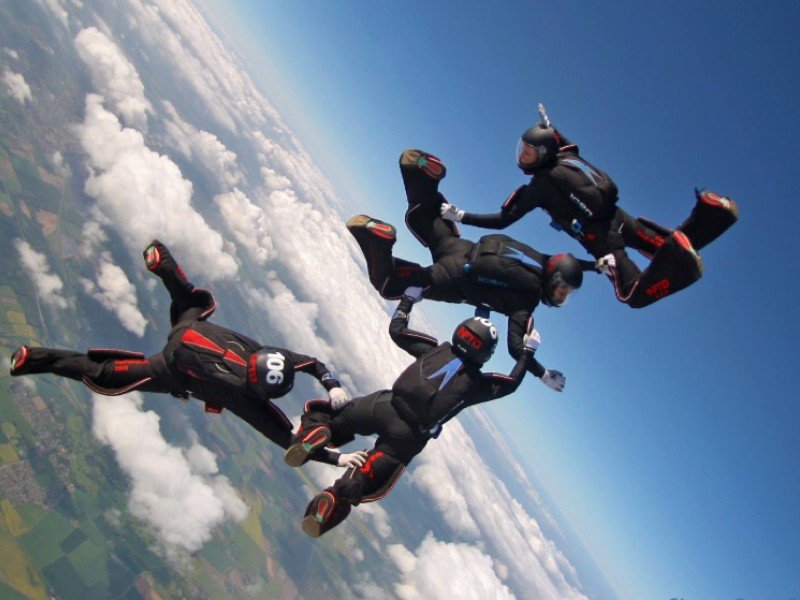For decades the Olympic motto has been “Citius, Altius, Fortius” (“Faster, Higher, Stronger”), and no sport would better suit such words than skydiving. But is skydiving an Olympic sport? Has it ever been an Olympic sport?
The Olympics is the premier sporting competition where the world watches the best athletes compete in the most fascinating sports. It has always attempted to change with the times, adding new sports and disciplines every four years. This year saw the introduction of surfing, skateboarding, and sports climbing, among the six new events, all of which provided compelling viewing. However, you may have noticed skydiving’s absence from this year’s games.
Let’s look at whether skydiving ever has, or ever will feature at the Olympic games. Let’s also explore the world of competitive skydiving and what events it includes.
Has skydiving ever been at the Olympics?

Parisian André-Jacques Garnerin performed the first parachute jump on October 22nd, 1797. He jumped from a hot air balloon at 2.230 feet. And survived! Leslie Irvin completed the first freefall dive in 1919. By the 1930s, competitive skydiving and parachuting had begun. Parachute quickly began to grow as a sport and hobby after World War II and has continued to rise in popularity ever since.
Despite the popularity of skydiving as a hobby and sport, it has never made its debut at the Olympics. There has never been an aeronautic sport at an Olympic Games. Hang gliding was due to debut at the 1940 Tokyo Olympics, but they canceled the Olympics after World War II began. Hang gliding is still yet to appear at the Olympic Games.
The Greek creators and hosts of the first Olympic games often mentioned water, earth, and air, as the elements in which athletes should compete, but no true ‘air’ sport is yet to appear on the Olympic stage.
How the Olympic board chooses which sports to bring in can often be a bit confusing. Skydiving is not alone as being a much love event which hasn’t had its chance, popular sports such as netball, squash, darts, and bowling have also never been include. And yet, some bizarre sports have. Showjumping is relatively elite enough, but at the 1900 Paris Olympics, they held a horse long jump competition. Weirder still, at those same Olympics, Poodle Clipping was an event!
Will skydiving be an Olympic sport in the future?

Despite some questionable choices of sport, the International Olympic Committee (IOC) does list specific criteria for new events.
Firstly the sport must have a ruling non-governmental organization recognized by the IOC, which abides by the Olympic Charter. Once recognized, it moves to International Sports Status (IF) and must abide by the Anti-Doping Code.
Skydiving already has a widely respected non-governmental governing body, the International Skydiving Commission (known as the FAI)
To then qualify for as an Olympic sport, it must then meet the following criteria:
- The sport must not be ‘elitist’ and must be practiced by men in at least 75 countries and four continents. Women must also practice it in at least 40 countries and three continents.
- The sports must add to the Games ‘value and appeal, holding up its competitive and sporting traditions.
- It’s must not purely be a ‘mind sport’ (such as chess) or rely on mechanical propulsion.
Skydiving can meet all the above criteria.
Other considerations are how much money the events would cost to host, how popular and relevant the sport is to the host country, and how great the general public and media interest would be. In addition, they analyze how old the sport is and how well establishes its national governing bodies are.
In terms of finances, while it would require jump planes, drop zones, skydiving camera operators, and some other equipment, it wouldn’t require any specialist buildings to be constructed or have heavy costs. Assessing how popular or relevant a skydiving event would be, the next host, Paris, France, is seen as the birthplace of parachuting. And on its global reach, this is a sport which would give great viewing. Competitive and formation skydiving has gained a massive following in China, the U.S., and Europe.
Could Indoor skydiving make it to the Paris 2024 Olympics?

While it may still seem unlikely that skydiving to make the Olympic games soon, there is genuine hope that indoor skydiving may be selected. There are several variations of competitive skydiving possible in skydiving wind tunnels. Artistic skydiving to music, head-to-head battles, team formations, and some speed disciplines have already competed in wind tunnels at the international level.
Paris’s next Olympic host already has two world-class wind tunnels and has hosted several international indoor skydiving competitions. The iFly wind tunnel arena is situated close to the Olympic Park and Stade de France. and is ideally suited to host an Olympic indoor skydiving event.
There is real hope that indoor skydiving can be added to Paris 2024. The French Parachute Federation (FFP) has recently hosted several international tournaments, showcasing its ability to organize large-scale events. The FFP has also worked closely with the FAI to create stronger bonds with other countries and global brands to bring more support and backing. The FAI has applied for its inclusion at the next Olympic games.
Is skydiving a competitive sport?

While many know skydiving as an experience or hobby, rather than being a competitive sport, it has a highly competitive side. There are numerous national and international skydiving competitions. The USPA annually hosts the National Skydiving Championships, including freestyle, artistic, accuracy, and speed events. On the international stage, the FAI hosts the World Parachuting Championships, which sees the best skydivers from all over the world compete.
Here are a few of the most popular competitive skydiving events explained:
Formation skydiving: Most commonly competed by teams of four or eight skydivers, each team must perform a pre-determined set of formations and sequences. The positions and formations can be stunning to watch.
Vertical Formation Skydiving: It’s the same principle as formation skydiving, but done so in the head down or head up positions. Due to this position, these dives are fast and gather speeds up to 180 MPH.
Freestyle: Performed with a videographer; this is an artistic solo event. Each skydiver must perform seven jumps, including five free choices and two compulsory routines. Skydivers are scored by the dives’ difficulty, style, and execution.
Freeflying: This is the two-person version of freestyle skydiving. Pairs of skydivers must perform seven artistic skydives and try to impress the judges with their moves. You’ll see back-loops, helicopters, daffy’s, and many other unique and imaginative moves.
Speed Skydiving: A relatively new discipline in competitive skydiving, the FIA first recognized the speed event in 2014. It’s a solo event where skydivers compete to be the quickest over a vertical kilometer. It’s lightning-fast, as you can imagine, performed at speeds over 250 MPH.
Skydiving Canopy Events

There are also a number of competitive events which take place after the parachute is deployed:
Canopy Piloting: This event is set over three different events: distance, speed, and accuracy. Each discipline tests a different set of parachuting techniques and abilities. Distance judges the pilots’ total distance covered over a pre-determined course. With accuracy canopy flying, competitors must aim to land on a 5cm disk!
Canopy Relative Work: This is a form of freestyle parachuting. Like free-flying, the team performs beautiful formations, docking onto each other to create stunning canopy stacks. Each team is judged by its ability to perform a set of protocols within a set time.
Swooping: This is a more recent addition to competitive skydiving and a product of the great control modern parachutes offer. It uses a technique that allows pilots to swoop close to the ground and then regain altitude. Competitors compete to cover impressive distances and perform artistic stunts. It’s often performed over water and can be stunning to watch.

